2011-2012学年第一学期语言学试题
- 格式:doc
- 大小:59.00 KB
- 文档页数:3
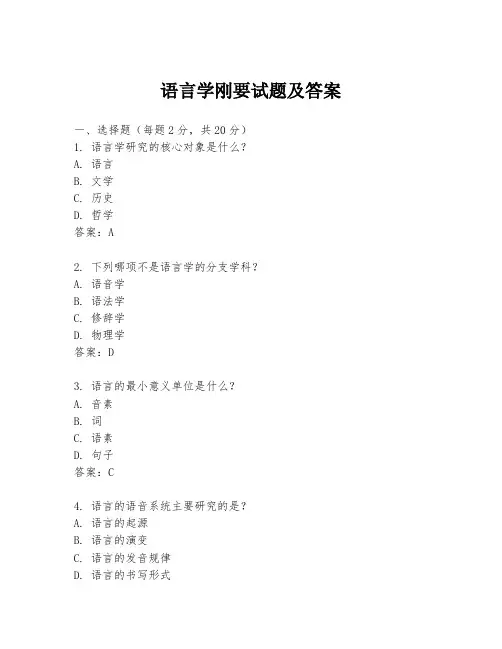
语言学刚要试题及答案一、选择题(每题2分,共20分)1. 语言学研究的核心对象是什么?A. 语言B. 文学C. 历史D. 哲学答案:A2. 下列哪项不是语言学的分支学科?A. 语音学B. 语法学C. 修辞学D. 物理学答案:D3. 语言的最小意义单位是什么?A. 音素B. 词C. 语素D. 句子答案:C4. 语言的语音系统主要研究的是?A. 语言的起源B. 语言的演变C. 语言的发音规律D. 语言的书写形式5. 语言的语法系统主要研究的是?A. 语言的发音规律B. 语言的书写形式C. 语言的词汇D. 语言的句法结构答案:D6. 语言的语义系统主要研究的是?A. 语言的发音规律B. 语言的句法结构C. 语言的意义D. 语言的书写形式答案:C7. 语言的语用系统主要研究的是?A. 语言的起源B. 语言的交际功能C. 语言的词汇D. 语言的句法结构答案:B8. 语言的演变主要受哪些因素的影响?A. 社会变迁B. 文化交流C. 科技发展D. 所有以上答案:D9. 语言的方言差异主要体现在哪些方面?B. 词汇C. 语法D. 所有以上答案:D10. 语言的标准化通常包括哪些方面?A. 语音B. 词汇C. 语法D. 所有以上答案:D二、填空题(每题2分,共20分)1. 语言学是研究人类________的科学。
答案:语言2. 语言的三大基本要素包括语音、________和语义。
答案:语法3. 语言的________是语言的最小意义单位。
答案:语素4. 语言学家通常将语言的演变分为内部演变和________。
答案:外部演变5. 语言的________系统主要研究语言的交际功能。
答案:语用6. 语言的________系统主要研究语言的意义。
答案:语义7. 语言的________系统主要研究语言的句法结构。
答案:语法8. 语言的________系统主要研究语言的发音规律。
答案:语音9. 语言学家将语言的方言差异归因于地理、社会和________等因素。
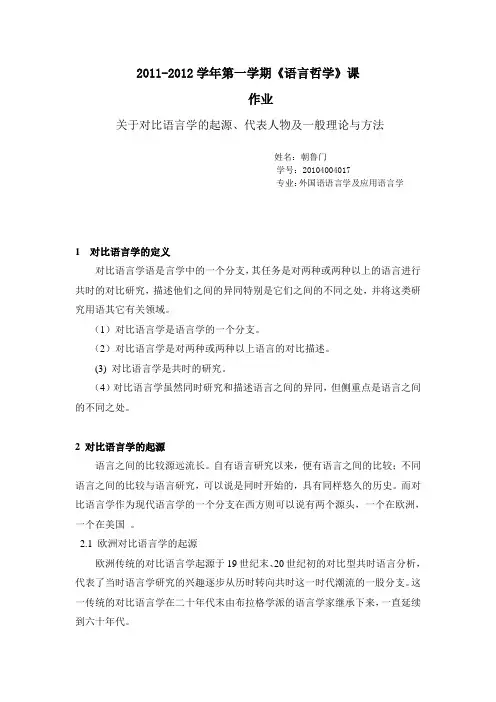
2011-2012学年第一学期《语言哲学》课作业关于对比语言学的起源、代表人物及一般理论与方法姓名:朝鲁门学号:20104004017专业:外国语语言学及应用语言学1 对比语言学的定义对比语言学语是言学中的一个分支,其任务是对两种或两种以上的语言进行共时的对比研究,描述他们之间的异同特别是它们之间的不同之处,并将这类研究用语其它有关领域。
(1)对比语言学是语言学的一个分支。
(2)对比语言学是对两种或两种以上语言的对比描述。
(3) 对比语言学是共时的研究。
(4)对比语言学虽然同时研究和描述语言之间的异同,但侧重点是语言之间的不同之处。
2 对比语言学的起源语言之间的比较源远流长。
自有语言研究以来,便有语言之间的比较;不同语言之间的比较与语言研究,可以说是同时开始的,具有同样悠久的历史。
而对比语言学作为现代语言学的一个分支在西方则可以说有两个源头,一个在欧洲,一个在美国。
2.1 欧洲对比语言学的起源欧洲传统的对比语言学起源于19世纪末、20世纪初的对比型共时语言分析,代表了当时语言学研究的兴趣逐步从历时转向共时这一时代潮流的一股分支。
这一传统的对比语言学在二十年代末由布拉格学派的语言学家继承下来,一直延续到六十年代。
2.2 美国对比语言语的起源美国传统的对比语言学起源于第二次世界大战期间,可以说是由当时外语教学的需要、行为主义心理学对外语教学理论的影响和美国结构主义语言学的发展这三股历史潮流汇合而成的。
教学效果最好的教材是以对所学语言进行科学的描述为基础,并将其与对学生的母语所做的同样描述进行仔细比较后所编程的那些教材。
3 对比语言学的代表人物及理论体系3.1叶斯帕森叶斯帕森(Otto Jespersen 1860-1943)被认为对英语语言最具权威的丹麦著名语言学家。
他的《语法哲学》奠定了他作为理论语言学家的地位。
他提倡语言的对比应该扩大研究范围,比较可以在同族语系中的语言中进行,也可以在不同语系或距离甚远的两种或多种语言中进行。
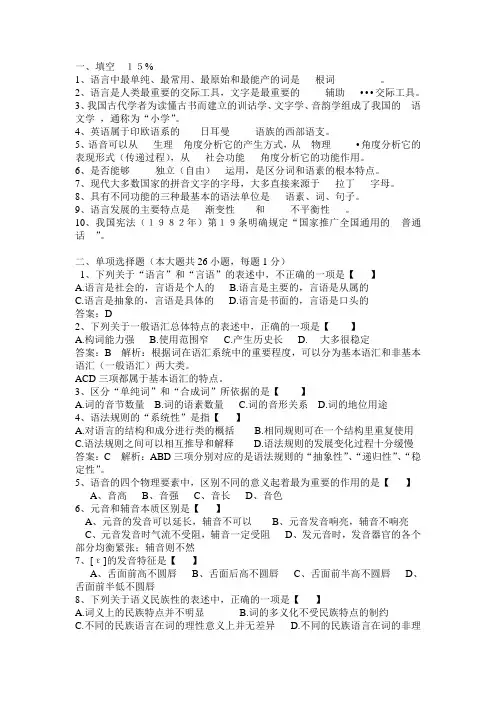
一、填空15%1、语言中最单纯、最常用、最原始和最能产的词是根词。
2、语言是人类最重要的交际工具,文字是最重要的辅助•••交际工具。
3、我国古代学者为读懂古书而建立的训诂学、文字学、音韵学组成了我国的语文学,通称为“小学”。
4、英语属于印欧语系的日耳曼语族的西部语支。
5、语音可以从生理角度分析它的产生方式,从物理•角度分析它的表现形式(传递过程),从社会功能角度分析它的功能作用。
6、是否能够独立(自由)运用,是区分词和语素的根本特点。
7、现代大多数国家的拼音文字的字母,大多直接来源于拉丁字母。
8、具有不同功能的三种最基本的语法单位是语素、词、句子。
9、语言发展的主要特点是渐变性和不平衡性。
10、我国宪法(1982年)第19条明确规定“国家推广全国通用的普通话”。
二、单项选择题(本大题共26小题,每题1分)1、下列关于“语言”和“言语”的表述中,不正确的一项是【】A.语言是社会的,言语是个人的B.语言是主要的,言语是从属的C.语言是抽象的,言语是具体的D.语言是书面的,言语是口头的答案:D2、下列关于一般语汇总体特点的表述中,正确的一项是【】A.构词能力强B.使用范围窄C.产生历史长D. 大多很稳定答案:B 解析:根据词在语汇系统中的重要程度,可以分为基本语汇和非基本语汇(一般语汇)两大类。
ACD三项都属于基本语汇的特点。
3、区分“单纯词”和“合成词”所依据的是【】A.词的音节数量B.词的语素数量C.词的音形关系D.词的地位用途4、语法规则的“系统性”是指【】A.对语言的结构和成分进行类的概括B.相同规则可在一个结构里重复使用C.语法规则之间可以相互推导和解释D.语法规则的发展变化过程十分缓慢答案:C 解析:ABD三项分别对应的是语法规则的“抽象性”、“递归性”、“稳定性”。
5、语音的四个物理要素中,区别不同的意义起着最为重要的作用的是【】A、音高B、音强C、音长D、音色6、元音和辅音本质区别是【】A、元音的发音可以延长,辅音不可以B、元音发音响亮,辅音不响亮C、元音发音时气流不受阻,辅音一定受阻D、发元音时,发音器官的各个部分均衡紧张;辅音则不然7、[ε]的发音特征是【】A、舌面前高不圆唇B、舌面后高不圆唇C、舌面前半高不圆唇D、舌面前半低不圆唇8、下列关于语义民族性的表述中,正确的一项是【】A.词义上的民族特点并不明显B.词的多义化不受民族特点的制约C.不同的民族语言在词的理性意义上并无差异D.不同的民族语言在词的非理性意义上会有所不同答案:D解析:不同民族对客观事物的认识不同,因而语义的民族特点也不同,词的多义化也会受制约,非理性意义也会有所不同,比如汉语中“狗”字常含贬义,像“走狗”;可在英语里,“dog”常含褒义,像“a lucky dog”(幸运儿)。
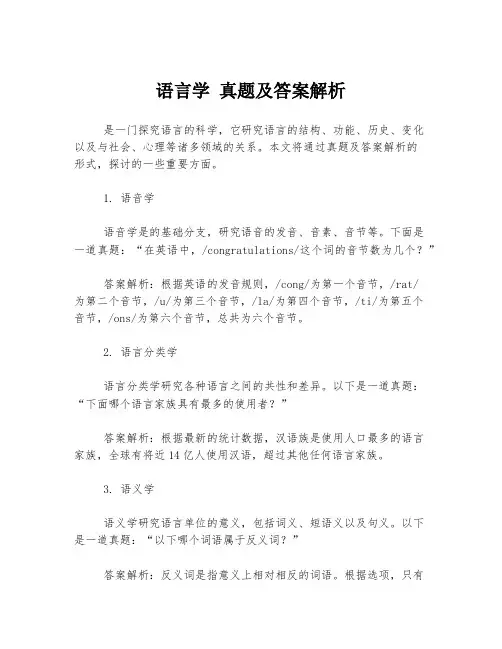
语言学真题及答案解析是一门探究语言的科学,它研究语言的结构、功能、历史、变化以及与社会、心理等诸多领域的关系。
本文将通过真题及答案解析的形式,探讨的一些重要方面。
1. 语音学语音学是的基础分支,研究语音的发音、音素、音节等。
下面是一道真题:“在英语中,/congratulations/这个词的音节数为几个?”答案解析:根据英语的发音规则,/cong/为第一个音节,/rat/为第二个音节,/u/为第三个音节,/la/为第四个音节,/ti/为第五个音节,/ons/为第六个音节,总共为六个音节。
2. 语言分类学语言分类学研究各种语言之间的共性和差异。
以下是一道真题:“下面哪个语言家族具有最多的使用者?”答案解析:根据最新的统计数据,汉语族是使用人口最多的语言家族,全球有将近14亿人使用汉语,超过其他任何语言家族。
3. 语义学语义学研究语言单位的意义,包括词义、短语义以及句义。
以下是一道真题:“以下哪个词语属于反义词?”答案解析:反义词是指意义上相对相反的词语。
根据选项,只有“上升”和“下降”是反义词关系,因此答案为“下降”。
4. 语用学语用学研究语言在实际交流中的使用和功能。
以下是一道真题:“在‘你能帮我一个忙吗?’这句话中,‘能’是表示请求还是表示能力?”答案解析:从句子的语境来看,“能”在这里是表示请求的意思,请求对方帮助。
因此,答案为“表示请求”。
5. 句法学句法学研究语言单位之间的组合和句子的结构。
以下是一道真题:“以下哪个是并列句?”答案解析:并列句是由并列连词连接的两个或多个主谓完整的句子,选项中只有D项“我喜欢音乐,我也喜欢电影。
”符合这个定义。
6. 语言变化语言是动态变化的,随着时间的推移,语言会发生变化。
以下是一道真题:“以下哪种语音变化是通过声调产生的?”答案解析:声调是语音的一种音高变化,在某些语言中,声调的变化可以改变词义。
因此,声调是一种通过声调产生的语音变化。
通过以上的真题及答案解析,我们可以看到的多个方面。
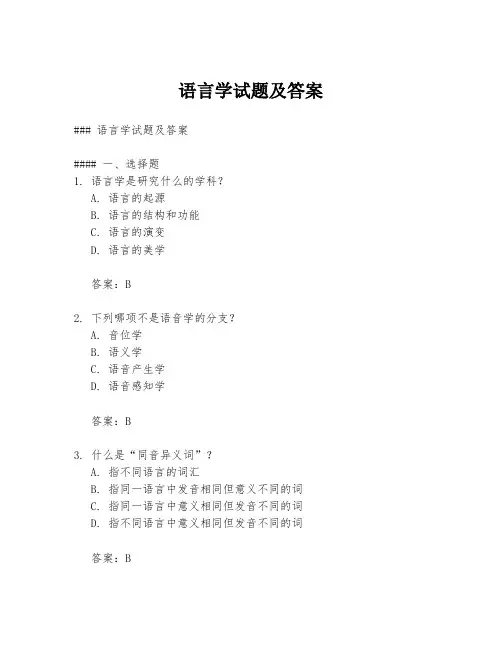
语言学试题及答案### 语言学试题及答案#### 一、选择题1. 语言学是研究什么的学科?A. 语言的起源B. 语言的结构和功能C. 语言的演变D. 语言的美学答案:B2. 下列哪项不是语音学的分支?A. 音位学B. 语义学C. 语音产生学D. 语音感知学答案:B3. 什么是“同音异义词”?A. 指不同语言的词汇B. 指同一语言中发音相同但意义不同的词C. 指同一语言中意义相同但发音不同的词D. 指不同语言中意义相同但发音不同的词答案:B#### 二、填空题4. 语言学的一个主要分支是________,它研究语言的意义。
答案:语义学5. 一种语言的语法规则可以描述该语言的________。
答案:结构6. 语言学中的“方言”指的是________。
答案:同一语言内部的地域性变体#### 三、简答题7. 简述语言的任意性原则。
答案:语言的任意性原则是指语言符号和它所代表的概念之间没有必然的逻辑或自然联系,这种关系是任意的,由社会约定俗成。
8. 什么是转换生成语法?答案:转换生成语法是一种语言学理论,由诺姆·乔姆斯基提出,主张语言的深层结构可以通过转换规则生成表层结构,从而解释语言的生成能力和多样性。
#### 四、论述题9. 论述语言和文化之间的关系。
答案:语言和文化是相互影响和塑造的。
语言不仅是文化的载体,通过语言可以传递文化信息和价值观;同时,文化也影响语言的使用和发展,如特定的社会习俗和信仰体系会影响语言的表达方式和词汇选择。
语言和文化共同构成了人类社会的认知和交流模式。
10. 描述语言习得的关键阶段及其特点。
答案:语言习得的关键阶段包括婴儿期、儿童早期和青少年期。
婴儿期是语言感知能力的发展阶段,儿童能够区分不同语言的音素。
儿童早期是语言习得的快速发展期,儿童开始学习语法规则并形成基本的语言能力。
青少年期则是语言习得的完善阶段,青少年继续扩展词汇量,提高语言运用的复杂性和准确性。
以上试题及答案涵盖了语言学的基础概念、理论以及与语言习得和文化的关系,旨在考察学生对语言学核心知识的掌握和理解。
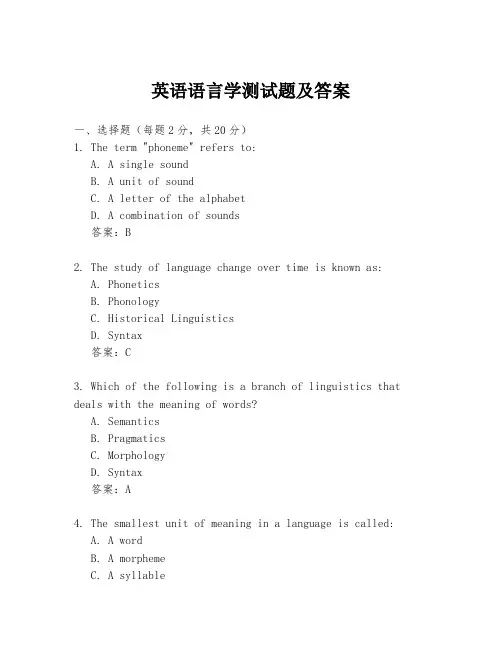
英语语言学测试题及答案一、选择题(每题2分,共20分)1. The term "phoneme" refers to:A. A single soundB. A unit of soundC. A letter of the alphabetD. A combination of sounds答案:B2. The study of language change over time is known as:A. PhoneticsB. PhonologyC. Historical LinguisticsD. Syntax答案:C3. Which of the following is a branch of linguistics that deals with the meaning of words?A. SemanticsB. PragmaticsC. MorphologyD. Syntax答案:A4. The smallest unit of meaning in a language is called:A. A wordB. A morphemeC. A syllableD. A phoneme答案:B5. The process of forming words by combining smaller units is known as:A. SyntaxB. MorphologyC. SemanticsD. Phonology答案:B6. The study of the rules governing the structure of sentences is called:A. SyntaxB. SemanticsC. PragmaticsD. Morphology答案:A7. The branch of linguistics that deals with the social context in which language is used is:A. SociolinguisticsB. PsycholinguisticsC. NeurolinguisticsD. Computational Linguistics答案:A8. The study of how language is processed in the brain is known as:A. PsycholinguisticsB. NeurolinguisticsC. SociolinguisticsD. Computational Linguistics答案:B9. The process of acquiring a first language is called:A. Second language acquisitionB. Foreign language learningC. Language learningD. First language acquisition答案:D10. The concept that language is arbitrary means that:A. It is randomB. It is meaninglessC. There is no necessary connection between the form of a word and its meaningD. It is always logical答案:C二、填空题(每题2分,共20分)1. The study of speech sounds is called ____________.答案:Phonetics2. The branch of linguistics that examines how language is used in social contexts is ____________.答案:Sociolinguistics3. The smallest meaningful unit of language is known as the ____________.答案:Morpheme4. The process of combining morphemes to form words is known as ____________.答案:Morphology5. The study of the way language is structured and organized is called ____________.答案:Linguistics6. The branch of linguistics that deals with the rules governing the formation of words is ____________.答案:Morphology7. The study of the way meaning is conveyed in language is known as ____________.答案:Semantics8. The branch of linguistics that deals with the rules governing the formation of sentences is ____________.答案:Syntax9. The study of the way language is used in everyday life is called ____________.答案:Pragmatics10. The study of the way language is processed in the brain is known as ____________.答案:Neurolinguistics三、简答题(每题10分,共40分)1. Explain the difference between phonetics and phonology.答案:Phonetics is the study of speech sounds and theirproduction, while phonology is the study of the sound system of a language, including the rules governing the use of these sounds.2. What is the Sapir-Whorf hypothesis?答案:The Sapir-Whorf hypothesis suggests that the language a person speaks influences the way they perceive the world and think.3. Describe the role of sociolinguistics in understanding language.答案:Sociolinguistics helps us understand how language varies with different social contexts, such as class, gender, ethnicity, and age, and how these variations influence language use.4. How does first language acquisition differ from second language acquisition?答案:First language acquisition is the process of learning a native language during early childhood, while second language acquisition is the process of learning a new language after the age of language development. The process of second language acquisition is influenced by the learner's first language and cognitive abilities.。
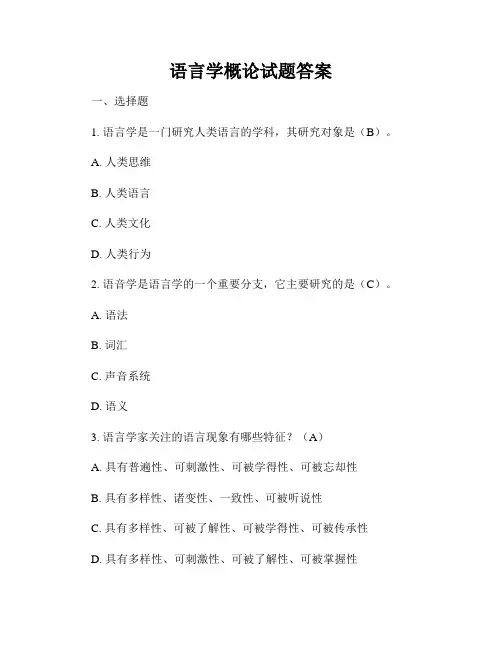
语言学概论试题答案一、选择题1. 语言学是一门研究人类语言的学科,其研究对象是(B)。
A. 人类思维B. 人类语言C. 人类文化D. 人类行为2. 语音学是语言学的一个重要分支,它主要研究的是(C)。
A. 语法B. 词汇C. 声音系统D. 语义3. 语言学家关注的语言现象有哪些特征?(A)A. 具有普遍性、可刺激性、可被学得性、可被忘却性B. 具有多样性、诸变性、一致性、可被听说性C. 具有多样性、可被了解性、可被学得性、可被传承性D. 具有多样性、可刺激性、可被了解性、可被掌握性4. 语言是人类思维的外在表现,它的特点包括(B)。
A. 符号性、逻辑性、经验性、情感性B. 音素性、词汇性、语法性、交际性C. 语音性、声调性、音节性、语义性D. 文化性、习得性、传承性、社会性5. 语言学的研究方法主要包括哪些方面?(D)A. 观察法、统计法、实验法、调查法B. 比较法、分析法、综合法、实证法C. 形态法、句法法、语义法、语用法D. 理论法、实证法、历时法、内在法二、简答题1. 什么是语音学?简述语音学的基本研究对象。
语音学是语言学的一个分支学科,主要研究的是语言中声音的产生、传播和感知机制。
它研究的基本对象是语音。
语音是一种由声音信号组成的符号系统,通过声音的不同组合和规则,人们能够进行语言的交际和沟通。
2. 语言学的研究范围包括哪些方面?简要描述其中两个方面的内容。
语言学的研究范围涵盖了语音、词汇、语法、语义和语用等多个方面。
其中语音学主要研究语言中的声音系统,通过研究语音的音素、音位和音系等要素来揭示其规律和变化。
而语法学研究语言中的句子构成和组合规律,包括短语结构、词类、句法关系等内容。
三、论述题语言作为人类最为基本的交流工具和思维表达方式,对于人类社会和文化的发展起到了重要的作用。
语言学作为一门学科,对于深入研究和探索语言的本质和规律具有重要意义。
首先,语言学研究语言的普遍性和多样性。
语言在世界各地的人类社会中普遍存在,但不同语言之间又表现出多样性。
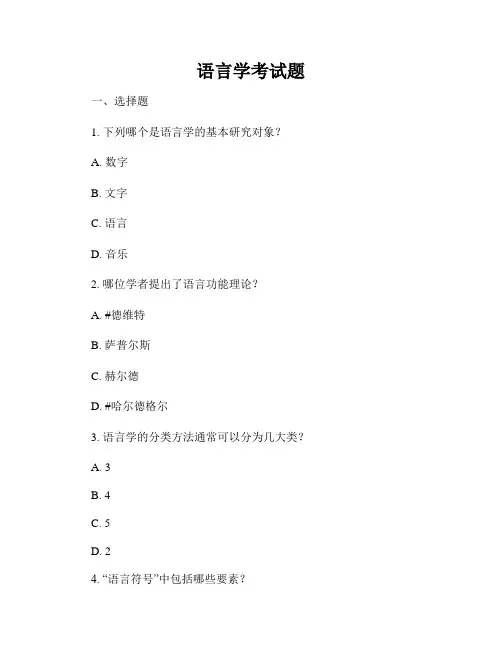
语言学考试题一、选择题1. 下列哪个是语言学的基本研究对象?A. 数字B. 文字C. 语言D. 音乐2. 哪位学者提出了语言功能理论?A. #德维特B. 萨普尔斯C. 赫尔德D. #哈尔德格尔3. 语言学的分类方法通常可以分为几大类?A. 3B. 4C. 5D. 24. “语言符号”中包括哪些要素?A. 声音B. 符号C. 拼写D. A、B5. 在语法范畴中,“动宾关系”是指什么?A. 主语和谓语之间的语法关系B. 主语和宾语之间的语法关系C. 宾语和谓语之间的语法关系D. 主语和动词之间的语法关系二、填空题6. 语言学中研究音素的学科是---。
7. 没有逻辑意义的音节称为---。
8. 语音学的基本单位是---。
9. 下列哪个不是语言学的分支学科?10. 一种语言中声母、韵母和声调三者综合的组合称为---。
三、简答题11. 请简要说明音韵学和语音学的区别。
12. 什么是“方言”,方言和语言的关系是什么?13. 什么是语法,语法的作用是什么?14. “文字和语言的关系”是语言学中一个重要问题,请简述你对这个问题的理解。
15. 请简要介绍语言学的研究方法有哪些?四、论述题16. 语言是人类最重要的交流工具之一,请说明语言对个体和社会的重要性。
17. 语言学的发展历程是怎样的?过去、现在和未来的语言学会有怎样的发展趋势?18. 请解释语言与文化之间的关系,并谈谈语言多样性对世界文化的重要影响。
以上便是本次语言学考试题的全部内容,请同学们认真地完成每一道题目,祝大家取得优异的成绩!。
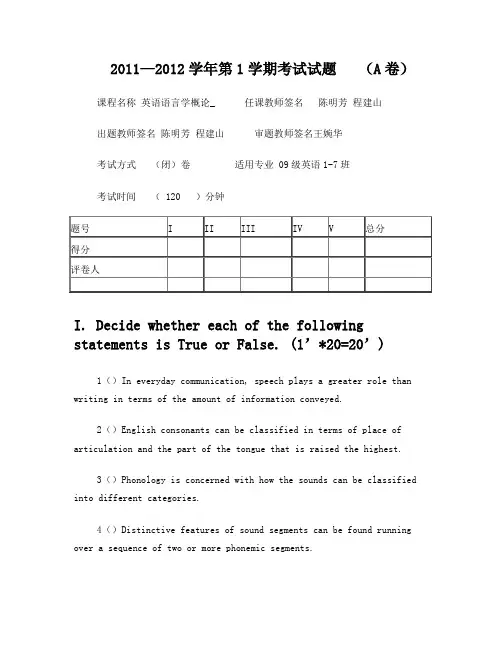
2011—2012学年第1学期考试试题(A卷)课程名称英语语言学概论_ 任课教师签名陈明芳程建山出题教师签名陈明芳程建山审题教师签名王婉华考试方式(闭)卷适用专业 09级英语1-7班考试时间( 120 )分钟I. Decide whether each of the followingst atements is True or False. (1’*20=20’)1()In everyday communication, speech plays a greater role than writing in terms of the amount of information conveyed.2()English consonants can be classified in terms of place of articulation and the part of the tongue that is raised the highest.3()Phonology is concerned with how the sounds can be classified into different categories.4()Distinctive features of sound segments can be found running over a sequence of two or more phonemic segments.5()General linguistics is generally the study of language as a whole.6()General linguistics, which relates itself to the research of other areas, studies the basic concepts, theories, descriptions, models and methods applicable in any linguistic study.7()Phonetics is different from phonology in that the latter studiesthe combinations of the sounds to convey meaning in communication.8()Morphology studies how words can be formed to produce meaningful sentences.9()Inflectional morphemes manifest various grammatical relationsor grammatical categories such as number, tense, degree, and case.10( ) The existing form to which a derivational affix can be added is called a stem, which can be a bound root, a free morpheme, or a derived form itself.11 ( ) Prefixes usually modify the part of speech of the original word, not the meaning of it.12 ( ) There are rules that govern which affix can be added to what type of stem to form a new word. Therefore, words formed according tothe morphological rules are acceptable words.13 ( ) Phonetically, the stress of a compound always falls on the first element, while the second element receives secondary stress.14 ( ) Syntax is a subfield of linguistics that studies the sentence structure of language, including the combination of morphemes into words.15 ( ) Dialectal synonyms can often be found in different regional dialects such as British English and American English but cannot befound within the variety itself, for example, within British English orAmerican English.16 ( ) Language use varies from one speech community to another, fromone regional group to another, from one social group to another, andeven from one individual to another.17 ( ) Every speaker of a language is, in a stricter sense, aspeaker of a distinct idiolect.18 ( ) The major difference between a pidgin and a creole is thatthe former usually has its native speakers while the latter doesn’t.19 ( ) Some languages are inferior, or superior, to other languages.20 ( ) Language acquisition is primarily the acquisition of thevocabulary and the meaning of language.II. Fill in each of the following blanks with one word which begins with the letter given. (1’*20=20’)1. English consonants can be classified in terms of manner of articulation or interms of p_______ of articulation.2. When the obstruction created by the speech organs is total or complete, thespeech sound produced with the obstruction audibly released and the air passingout again is called a s________.3. S_________ features are the phonemic features that occur above thelevel of the segments. They include stress, tone, intonation, etc.4. The rules that govern the combination of sounds in a particular language arecalled s____ rules.5. P____ refers to the realization of langue in actual use.6. Findings in linguistic studies can often be applied to the settlement of somepractical problems. The study of such applications is generally known asa________ linguistics.7. Language is p___________ in that it makes possible the construction and inter-pretation of new signals by its users. In other words, they can produce andunderstand an infinitely large number of sentences which they have never heardbefore.8. Linguistics is generally defined as the s____ study of language.9. A s______ is added to the end of stems to modify the meaning of the original word and it may change its part of speech.10. C__________ is the combination of two or sometimes more than two words to create new words.11. Morphemes which can be used all by themselves are known asf__________ morphemes.12. In terms of morphemic analysis, d_______________ can be viewed asthe addition of affixes to stems to form new words.13. A s______ can be a bound root, a free morpheme, or a derived form itself to which a derivational affix can be added.14. A c_________ sentence contains two, or more, clauses, one of whichis incorporated into the other.15. In the complex sentence, the incorporated or subordinate clause is normally called an e_______ clause.16. Major lexical categories are o___ categories in the sense that new words are constantly added.17. Minor lexical categories are c___ categories in the sense that no new words can be added.18. Whether a sentence is semantically meaningful is governed by rules called s________ restrictions, which are constraints on what lexical items can go with what others.19. An a________ is a logical participant in a predication, largely identical with the nominal element(s) in a sentence.20. According to the n____ theory of meaning, the words in a languageare taken to be labels of the objects they stand for.III. There are four choices following each of the statements below. Mark the choice that can best complete the statement. (1’*20=20’)1.Since /p/ and /b/ are phonetically similar, occur in the same environments andthey can distinguish meaning, they are said to be ___________.A. in phonemic contrastB. in complementarydistribution C. the allophones D.minimal pair2.The sound /f/ is _________________.A. voiced palatal affricateB. voiced alveolar stopC. voiceless velar fricativeD. voiceless labiodental fricative3 A ____ vowel is one that is produced with the front part of the tonguemaintaining the highest position.A. backB. centralC. frontD. middle4. Distinctive features can be found running over a sequence of two or morephonemic segments. The phonemic features that occur above the level of thesegments are called ____________.A. phonetic componentsB. immediate constituentsC. suprasegmental featuresD. semantic features5. If a linguistic study describes and analyzes the language people actually use, it is said to be ______________.A. prescriptiveB. analyticC. descriptiveD. linguistic6.Which of the following is not a design feature of human language?A. ArbitrarinessB. DisplacementC. DualityD. Meaningfulness7. Modern linguistics regards the written language as ____________.A. primaryB. correctC. secondaryD. stable8. In modern linguistics, speech is regarded as more basic than writing, because ___________.A. in linguistic evolution, speech is prior to writingB. speech plays a greater role than writing in terms of the amount ofinformation conveyed.C. speech is always the way in which every native speaker acquires his mothertongueD. All of the above9. The morpheme “vision” in the common word “television” is a(n) ______.A. bound morphemeB. bound formC. inflectional morphemeD. free morpheme10. The compound word “bookstore” is the place where books are sold. Thisindicates that the meaning of a compound __________.A. is the sum total of the meaning of its componentsB. can always be worked out by looking at the meanings of morphemesC. is the same as the meaning of a free phrase.D. None of the above.11. The part of speech of the compounds is generally determined by the part ofspeech of __________.A. the first elementB. the second elementC. either the first or the second elementD. both the first and the second elements.12. _______ are those that cannot be used independently but have to be combined with other morphemes, either free or bound, to form a word.A. Free morphemesB. Bound morphemesC. Bound wordsD. Words13. _________ is a branch of grammar which studies the internalstructure ofwords and the rules by which words are formed.A. SyntaxB.GrammarC. MorphologyD. Morpheme14. Syntactic movement is dictated by rules traditionally called________.A. transformational rulesB. generative rulesC. phrase structure rulesD. x-bar theory15. The theory of case condition accounts for the fact that __________.A. noun phrases appear only in subject and object positions.B. noun phrases can be used to modify another noun phraseC. noun phrase can be used in adverbial positionsD. noun phrase can be moved to any place if necessary.16. The sentence structure is ________.A. only linearB. Only hierarchicalC. complexD. both linear and hierarchical17. The syntactic rules of any language are ____ in number.A. largeB. smallC. finiteD. infinite18. ___________ refers to the phenomenon that words havingdifferent meaningshave the same form.A. PolysemyB. SynonymyC. HomonymyD. Hyponymy19. Words that are close in meaning are called ______________.A. homonymsB. polysemyC. hyponymsD. synonyms20. The grammaticality of a sentence is governed by _______.A. grammatical rulesB. selectional restrictionsC. semantic rulesD. semantic featuresIV. Define the terms below. (4’ *4=16’)1. minimal pair2. pragmatics3. synonymy4. second language acquisitionV. Comment on the following topics as comprehensively as possible.(8’*3=24’)1.( 8’) The major differences betwe en grammatical analysis andpragmatics.2. Explain violation of the maxims in the following and the implicature1)( 4’) (If one chooses B instead of A, what does he imply?)A: Miss X sang “Home sweet home”.B: Miss X produced a series of sounds that corresponded closelywith the score of “Home sweet home”.2)( 4’) War is war.3. (8’) How do the learner factors potentially influence the wayin which asecond language is acquired?2011—2012学年第1学期考试答卷(A卷)课程名称_ 英语语言学概论_ 出题教师签名:陈明芳程建山Name_____________ Class_____________ Number___________ __ Score_____________I. Decide whether each of the following statements is True or False. (1*20=20’)1-5 _____________ 6-10 _____________11-15____________ 16-20_____________II. Fill in each of the following blanks with one word which begins with the letter given. (1’*10=20’)1.___________2.___________3.___________4._____________5.______________6.___________7.___________8.___________9._____________10._____________11.__________ 12.__________13.__________14.____________15._____________16.__________17.__________18.__________19._____________20._________ ____III. There are four choices following each of the statements below. Mark the choice t hat can best complete the statement. (2’*10=20’)1-5________________ 6-10 _____________11-15 _____________ 16-20_____________IV. Define the terms below. (4’*4=16’)1.2.3.4.V. Comment on the following topics as comprehensively as possible. (8’*3=24’)1.2.1)2)3.2011—2012学年第1学期考试参考答案(A卷)课程名称英语语言学概论__ 出题教师签名:陈明芳程建山I. Decide whether each of the following statements is True or False. (1*20=20’)1-5 TFFTT 6-10 FTFTT 11-15 FFTFF 16-20TTFFFII. Fill in each of the following blanks with one word which begins with the letter given. (1’*10=20’)1-5place, stop, Suprasegmental, sequential, Parole 6-10 applied, productive, scientific/systemic, suffix, compounding 11-15 free, derivation, stem, complex, embedded 16-20 open, close, selectional, argument, namingIII. There are four choices following each of the statements below. Mark the choice that can best complete the statement. (1’*20=20’)1-5 ADCCC 6-10 DCDDD 11-15BBCAA 16-20DCCDAIV. Defi ne the terms below. (4’*4=16’)1. minimal pair: When two different forms are identical in every way except for one sound segment which occurs in the same place in the strings, the two words are said to form a minimal pair.2. pragmatics: the study of meaning in use in different context.3. synonymy. By synonymy we mean the sameness or similarity in meaning.4. second language acquisition: Second language acquisition (SLA)is a general term which refers to the acquisition of a second language (L2) , in contrast with first language acquisition (FLA). SLA is also used as a general term to refer to the acquisition of a foreign or subsequent language (such as a third or fourth language). Thus, SLA is primarily the study of how learners acquire or learn an additional language after they have acquired their first language (LI).V. Comment on the following topics as comprehensively as possible.(8’*3=24’)1. (8’)The major differences between grammatical analysis and pragmatics lie infour respects: The former studies sentences as units of the abstract linguistic system while the latter studies utterances as instances of the system. The former stops at the sentence level; the latter looks at bigger chunks of conversation.The former regards sentences as stable products; the latter treats utterances as dynamicprocess-es. The former analyses sentences in isolation; the latter analyses utterances inclose connection with their contexts of situation.2. (1) (4’) (If one chooses B instead of A, what does he imply?)A: Miss X sang “Home sweet home”.B: Miss X produced a series of sounds that corresponded closely with the score of “Home sweet home”.The speaker violates the maxim of manner by using such a long sentence to describe the act of Miss X. The impl ication is “Miss X sings so badly that he can hardly use the word ‘sing’ to describe her act.(2) (4’) The speaker violates the maxim of quantity. It implies “it’s no use lamenting on wars.Terrible things always happen. That’s its nature.”3. (8’) How do the learner factors potentially influence the way in which asecond language is acquired?1) The optimum age for second language acquisition: First language acquisition is most successful when it occurs during the early years of one’s life before puber ty, but the optimum age for SLA does not always accord with the maxim of ‘theyounger the better’. The optimum age for SLA is early teenage. This claim is justi-fiable because this is the age when the learner’ s flexibility of the language acquisition faculty has not been completely lost while one's cognitive skills have developed considerably.2) Motivation: Motivation in language learning can be defined in terms of the learner’s overall goal or orientation. Instrumental motivation occurs when the learn er’s goal is functional, and integrative motivation occurs when the learner’s goal is social. If the target language functions as a foreign language (used in a limited environment such as in school), the learner is likely to benefit from an integrative motivation; but if the target language functions as a second language (used as a primary means of communication in the community of the learner), an instrumental motivation is more effective.3) Acculturation: The acculturation hypothesis focuses on the social and psychological conditions under which L2 processing is most likely to take place successfully. It states simply that the more a person aspires to acculturate to the community of the target language, the further he or she will progress along the developmental continuum.4) Personality: Intuitively, an outgoing personality may contribute to language acquisition. Research results, however, only partially support this hypothesis. No significant relationship has been found between talkativeness on the one hand and overall proficiency in a second language on the other. But it is recognized that as a result of being frequently exposed to and interacting with the target language, learners with an extroverted personality are likely to achieve better oral fluency than otherwise.In sum, a good second language learner is, among other things, an adolescent who has a strong and well-defined motivation to learn. He isable to respond and adaptable to different learning situations. He seeks out all opportunities and makes maximum use of them to interact with the input. He employs appropriate learning strategies. And he is willing to identify himself or herself with the culture of the。
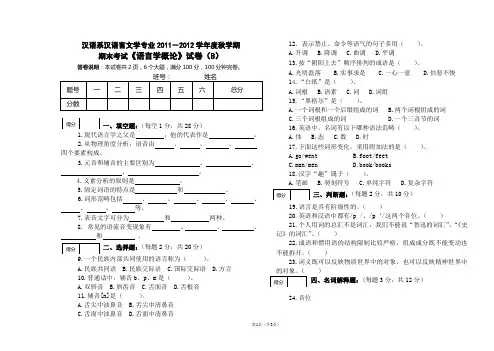
汉语系汉语言文学专业2011-2012学年度秋学期期末考试《语言学概论》试卷(B)答卷说明:本试卷共2页,6个大题,满分100分,100分钟完卷。
一、填空题:(每空1分,共28分)1.现代语言学之父是,他的代表作是。
2.从物理角度分析,语音由、、、四个要素构成。
3.元音和辅音的主要区别为、、、。
4.义素分析的原则是。
5.固定词语的特点是和。
6.词形范畴包括、、、、、、、等。
7.表音文字可分为和两种。
8. 常见的语流音变现象有、、、和。
二、选择题:(每题2分,共20分)9.一个民族内部共同使用的语言称为()。
A.民族共同语B.民族交际语C.国际交际语D.方言10.普通话中,辅音b、p、m是()。
A.双唇音B.唇齿音C.舌面音D.舌根音11.辅音[n]是()。
A.舌尖中浊鼻音B.舌尖中清鼻音C.舌面中浊鼻音D.舌面中清鼻音12.表示禁止、命令等语气的句子多用()。
A.升调B.降调C.曲调D.平调13.按“阴阳上去”顺序排列的成语是()。
A.光明磊落B.实事求是C.一心一意D.怙恶不悛14.“白纸”是()。
A.词根B.语素C.词D.词组15.“黑格尔”是()。
A.一个词根和一个后缀组成的词B.两个词根组成的词C.三个词根组成的词D.一个三音节的词16.英语中,名词有以下哪种语法范畴()。
A.体B.态C.数D.时17.下面这些词形变化,采用附加法的是()。
A.go/wentB.foot/feetC.man/menD.book/books18.汉字“趣”属于()。
A.笔画B.契刻符号C.单纯字符D.复杂字符三、判断题:(每题2分,共10分)19.语言是具有阶级性的。
()20.英语和汉语中都有/p /、/p‘/这两个音位。
()21.个人用词的总汇不是词汇,我们不能说“鲁迅的词汇”、“《史记》的词汇”。
()22.成语和惯用语的结构限制比较严格,组成成分既不能变动也不能拆开。
()23.词义既可以反映物质世界中的对象,也可以反映精神世界中的对象。
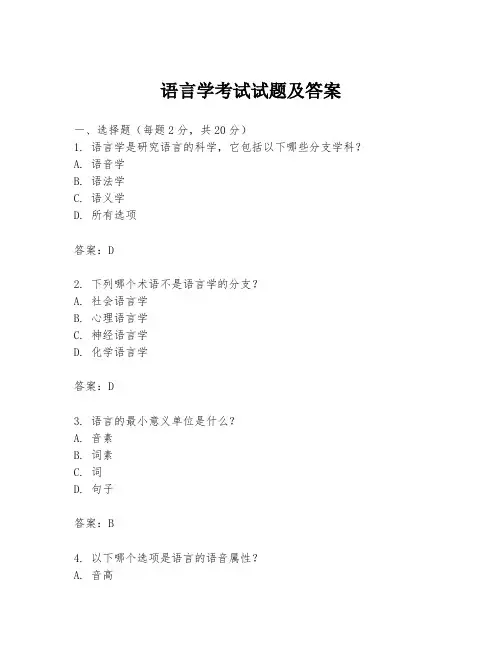
语言学考试试题及答案一、选择题(每题2分,共20分)1. 语言学是研究语言的科学,它包括以下哪些分支学科?A. 语音学B. 语法学C. 语义学D. 所有选项答案:D2. 下列哪个术语不是语言学的分支?A. 社会语言学B. 心理语言学C. 神经语言学D. 化学语言学答案:D3. 语言的最小意义单位是什么?A. 音素B. 词素C. 词D. 句子答案:B4. 以下哪个选项是语言的语音属性?A. 音高B. 音长C. 音色D. 所有选项答案:D5. 语言的语法规则可以是:A. 显性的B. 隐性的C. 两者都是D. 两者都不是答案:C6. 以下哪种语言现象不属于语言变异?A. 方言B. 社会方言C. 语言接触D. 语言消亡答案:D7. 语言的演变通常被认为是:A. 随机的B. 有目的的C. 无意识的D. 有意识的答案:C8. 语言接触可能导致:A. 语言融合B. 语言分离C. 语言借用D. 所有选项答案:D9. 语言的语用学研究的是:A. 语言的语境B. 语言的功能C. 语言的意义D. 所有选项答案:D10. 以下哪个术语不属于语义学研究的范围?A. 语义场B. 语义角色C. 语义关系D. 音位学答案:D二、填空题(每题2分,共20分)1. 语言的______属性包括音高、音长和音色。
答案:语音2. 语言的______属性包括语法、词汇和语义。
答案:结构3. 语言的______属性涉及语言的社会和文化方面。
答案:社会4. 语言学中的______理论认为语言是一系列规则的集合。
答案:形式主义5. 语言的______是语言学研究的基础单位。
答案:句子6. 语言的______是指语言在不同社会群体中的变体。
答案:变异7. 语言的______是指语言在不同地理区域的变体。
答案:方言8. 语言的______是指语言在不同时间的演变。
答案:历史9. 语言的______是指语言在不同语境中的使用。
答案:语用10. 语言的______是指语言的抽象意义。
语言学全部习题1. 简答题(每题10分,共30分)1) 什么是语言学?语言学是研究语言的科学,包括语音学、词法学、句法学、语义学、语用学等不同的分支。
它关注语言的结构、用法、演变以及和思维、社会和文化之间的关系。
2) 语言的基本要素包括哪些?语言的基本要素包括语音、词汇、句法、语义和语用。
语音研究发音和音系,词汇研究词的形态和词义,句法研究语言的句子结构,语义研究词和句的含义,语用研究语言的使用和交际。
3) 语音学和音系学有何区别?语音学研究语言中的语音现象,包括语音的产生、传播和感知等方面。
音系学研究语言中的音素系统,即语言中所有可能出现的音位和它们的组合规则。
2. 选择题(每题10分,共40分)1) 下列哪个不属于语言的基本要素?A. 语音B. 词汇C. 句法D. 语文答案:D2) 以下哪个学科不是语言学的分支?A. 语音学B. 语用学C. 数学D. 词法学答案:C3) 语音学主要研究哪方面的内容?A. 词义B. 词形C. 词语的使用D. 语音的产生和感知答案:D4) 以下哪个不是语言学的研究对象?A. 词汇表B. 句子结构C. 语言和思维的关系D. 社会语言规范答案:A3. 简答题(每题10分,共30分)1) 什么是语言的演变?语言的演变是指语言在使用过程中,由于多种因素的影响,其语音、词汇、句法等方面发生变化和发展。
语言的演变是一个长期的、渐进的过程,涉及到语言交流者的语言习惯、语音产生的方式、语法规则的改变等方面的变化。
2) 语言和思维之间有何关系?语言和思维之间有密切的关系。
一方面,语言是人类思维的表达工具,通过语言的运用,人们能够将思维中的概念、情感和意图等传递给他人。
另一方面,语言也影响思维的方式和内容。
语言结构和词汇的差异会影响人们的思维方式,不同语言对概念的划分和认知方式可能会有所不同。
3) 什么是语言交际?语言交际指的是人们通过语言进行沟通和交流的过程。
语言交际包括语言的使用、理解和解释,以及交流中的非语言行为和语境等因素。
山西师范大学研究生课程考试试题(卷)2011 ————2012 学年第一学期专业:语言学及应用语言学年级:09级学号:田静姓名:209415100----------------------------------------------------------------------------------------------------------------------英汉词语文化语义研究内容提要最近20年内,学科之间交叉融合的特点越来越明显。
当代语言学发展的轨迹也从语言的本体符号研究慢慢转向语言的认知属性研究,人文学科只有通过交叉融合才能找到新的增长点,才能对语言的本质属性探索得更全面。
但是目前国内关于从语用和认知的角度对英汉词语文化语义进行对比研究的专注还是极为罕见的。
本文将从词语文化语义概念的界定,英汉词语文化语义的成因以及英汉词语文化语义的研究对第二语言习得产生的影响来进行对比研究,通过从语言和文化的互动关系这个角度,研究词语文化语义的产生和影响,以促进跨文化交际的顺利进行和对词语民族文化语义的正确理解。
关键词:词语文化语义第二语言习得语言是一种音义结合的符号系统,语言的符号系统一般是由语音、语法、词汇及语义四大系统构成的,其中词汇和语义属于比较活跃的单位,词作为语言中最小的音义结合和独立使用的单位,是人们用来表达思想的语言符合,每个词都是由一定的语音特征、语法功能和语义结构组成的统一体。
每个词和每个词可以组合成词组,每个词和每个词组可以组合成句子,而一个句子的意义是由组成这个句子的全部词的意义组合而成的。
所以分析和研究词义对于分析句子,对于整个语篇都有极其重要的意义。
一、词语文化语义概念的界定词义不仅在语言学中有着十分重要的地位,而且在语义学中也一直占有中心地位。
就从研究的对象和范畴来看,语义学可以分为语言学的语义学、逻辑学的语义学、哲学的语义学和普通语义学。
伍谦光的《语义学导论》也是我国最早的并且很有影响的综合语义学研究著作,而且对西方语言学的语义学做了全面介绍(伍谦光,1988),随后徐烈炯出版了《语义学》一书(1990),全面综合性地介绍了西方的各种语义理论。
语言学第一章试题及答案一、选择题(每题2分,共20分)1. 语言学是研究人类语言的科学,它主要研究语言的哪些方面?A. 语音、语法、语义B. 语音、语法、语用C. 语音、语义、语用D. 语法、语义、语用答案:C2. 以下哪个选项不属于语言的组成部分?A. 词汇B. 语法C. 语义D. 逻辑答案:D3. 语言的最小意义单位是什么?A. 音素B. 词C. 语素D. 句答案:C4. 语言学的哪一项研究关注语言在社会中的使用?A. 语音学B. 语法学C. 语用学D. 语义学答案:C5. 以下哪种语言现象属于语言的演变?A. 音变B. 词义演变C. 句法结构变化D. 所有以上答案:D6. 语言的哪一部分是研究语言的物理属性?A. 社会语言学B. 心理语言学C. 语音学D. 计算语言学答案:C7. 以下哪个选项是研究语言如何表达意义的学科?A. 语音学B. 语用学C. 语义学D. 句法学答案:C8. 语言学中,研究语言如何随时间变化的学科是什么?A. 历史语言学B. 心理语言学C. 社会语言学D. 计算语言学答案:A9. 以下哪个选项是研究语言的起源和发展的学科?A. 比较语言学B. 心理语言学C. 历史语言学D. 社会语言学答案:C10. 语言学中的“转换生成语法”理论是由谁提出的?A. 弗洛伊德B. 乔姆斯基C. 索绪尔D. 布隆菲尔德答案:B二、填空题(每题2分,共10分)1. 语言学的主要分支包括语音学、语法学、语义学和______。
答案:语用学2. 语言的三个基本功能是表达思想、______和表达情感。
答案:交流信息3. 语言学中的“深层结构”和“表层结构”的概念是由______提出的。
答案:乔姆斯基4. 语言的最小音义结合单位是______。
答案:词5. 语言学研究的两个主要对象是语言和______。
答案:言语三、简答题(每题5分,共20分)1. 简述语言学的主要研究内容。
答案:语言学主要研究语言的结构、意义、使用和演变等方面,包括语音学、语法学、语义学、语用学、社会语言学、心理语言学等分支。
对比语言学(总9页) -本页仅作为预览文档封面,使用时请删除本页-2011-2012学年第一学期《语言哲学》课作业关于对比语言学的起源、代表人物及一般理论与方法姓名:朝鲁门学号:017专业:外国语语言学及应用语言学1 对比语言学的定义对比语言学语是言学中的一个分支,其任务是对两种或两种以上的语言进行共时的对比研究,描述他们之间的异同特别是它们之间的不同之处,并将这类研究用语其它有关领域。
(1)对比语言学是语言学的一个分支。
(2)对比语言学是对两种或两种以上语言的对比描述。
(3) 对比语言学是共时的研究。
(4)对比语言学虽然同时研究和描述语言之间的异同,但侧重点是语言之间的不同之处。
2 对比语言学的起源语言之间的比较源远流长。
自有语言研究以来,便有语言之间的比较;不同语言之间的比较与语言研究,可以说是同时开始的,具有同样悠久的历史。
而对比语言学作为现代语言学的一个分支在西方则可以说有两个源头,一个在欧洲,一个在美国。
欧洲对比语言学的起源欧洲传统的对比语言学起源于19世纪末、20世纪初的对比型共时语言分析,代表了当时语言学研究的兴趣逐步从历时转向共时这一时代潮流的一股分支。
这一传统的对比语言学在二十年代末由布拉格学派的语言学家继承下来,一直延续到六十年代。
美国对比语言语的起源美国传统的对比语言学起源于第二次世界大战期间,可以说是由当时外语教学的需要、行为主义心理学对外语教学理论的影响和美国结构主义语言学的发展这三股历史潮流汇合而成的。
教学效果最好的教材是以对所学语言进行科学的描述为基础,并将其与对学生的母语所做的同样描述进行仔细比较后所编程的那些教材。
3 对比语言学的代表人物及理论体系叶斯帕森叶斯帕森(Otto Jespersen 1860-1943)被认为对英语语言最具权威的丹麦著名语言学家。
他的《语法哲学》奠定了他作为理论语言学家的地位。
他提倡语言的对比应该扩大研究范围,比较可以在同族语系中的语言中进行,也可以在不同语系或距离甚远的两种或多种语言中进行。
英语语言学试题(1)I. Directions: Read each of the following statements carefully. Decide which one of the four choices best completes the statement and put the letter A, B, C or D in the brackets. (2%×10=20%)1、As modern linguistics aims to describe and analyze the language people actually use, and not to lay down rules for "correct" linguistic behavior, it is said to be ___.A、 prescriptiveB、 sociolinguisticC、 descriptiveD、psycholinguistic2、Of all the speech organs, the ___ is/are the most flexible.A、 mouthB、 lipsC、 tongueD、 vocal cords3、The morpheme "vision" in the common word "television" is a(n) ___.A、 bound morphemeB、 bound formC、 inflectional morphemeD、free morpheme4、A ___ in the embedded clause refers to the introductory word that introduces the embedded clause.A、 coordinatorB、 particleC、 prepositionD、 subordinator5、"Can I borrow your bike?" _____ "You have a bike."A、 is synonymous withB、 is inconsistent withC、 entailsD、presupposes6、The branch of linguistics that studies how context influences the way speakers interpret sentences is called ___.A、 semanticsB、 pragmaticsC、 sociolinguisticsD、psycholinguistics7、Grammatical changes may be explained, in part, as analogic changes, which are ___ or generalization.A、 elaborationB、 simplificationC、 external borrowingD、internal borrowing8、___ refers to a marginal language of few lexical items and straightforward grammatical rules, used as a medium of communication.A、 Lingua francaB、 CreoleC、 PidginD、 Standard language9、Psychologists, neurologists and linguists have concluded that, in addition to the motor area which is responsible for physical articulation of utterances, three areas of the left brain are vital to language, namely, ___ .A、 Broca's area, Wernicke's area and the angular gyrusB、 Broca's area, Wernicke's area and cerebral cortexC、 Broca's area, Wernicke's area and neuronsD、 Broca's area, Wernicke's area and Exner's area10、According to Krashen, ___ refers to the gradual and subconscious development of ability in the first language by using it naturally in daily communicative situations.A、 learningB、 competenceC、 performanceD、 acquisitionII. Directions: Fill in the blank in each of the following statements with one word, the first letter of which is already given as a clue. Note that you are to fill in One word only, and you are not allowed to change the letter given. (1%×10=10%)11、Chomsky defines "competence" as the ideal user's k_______ of the rules of his language.12、The four sounds /p/,/b/,/m/ and /w/have one feature in common, i.e, they are all b______ .13、M_______ is a branch of grammar which studies the internal structure of words and the rules by which words are formed.14、A s______ is a structurally independent unit that usually comprises a number of words to form a complete statement, question or command.15、Synonyms that are mutually substitutable under all circumstances are called c______ synonyms.16、The illocutionary point of r_____ is to commit the speaker to something's being the case, to the truth of what has been said.17、Words are created outright to fit some purpose. Such a method of enlarging the vocabulary is known as word c______.18、Wherever the standard language can use a contraction (he+is→he's), Black English can d___ the form of "be".19、The basic essentials of the first language are acquired in the short period from about age two to puberty, which is called the c______period for first language acquisition.20、As a type of linguistic system in 12 learning, I ______is a product of L2 training, mother tongue intereference, overgeneralization of the target language rules, and learning and communicative strategies of the learner. III. Directions: Judge whether each of the following statements is true or false. Put a T for true or F for false in the brackets in front of each statement. If you think a statement is false, you must explain why youthink so and give the correct version. (2%×10=20%)( )21、In modern linguistic studies, the written form of language is given more emphasis than the spoken form for a number of reasons.( )22、Voicing is a phonological feature that distinguishes meaning in both Chinese and English.( )23、The compound word "bookstore" is the place where books are sold. This indicates that the meaning of a compound is the sum total of the meanings of its components.( )24、Syntactic categories refer to sentences (S) and clauses (C) only. ( )25、Dialectal synonyms can often be found in different regional dialects such as British English and American English but cannot be found within the variety itself, for example, within British English or American English.( )26、Only when a maxim under Cooperative Principle is blatantly violated and the hearer knows that it is being violated do conversational implicatures arise.( )27、The territory in which the Indo-European languages are mainly spoken today also includes languages that are not Indo-European.( )28、In most bilingual communities, two languages have the same in speech situations known as domains.( )29、According to the strong version of the Sapir-Whorf hypothesis, speakers' perceptions determine language and pattern their way of life.( )30、All normal children have equal ability to acquire their first language. IV. Directions: Explain the following terms, using one or two examples for illustration. (3%×10=30%)31、duality32、diachronic linguistics33、broad transcription34、morphological rules35、phrase structure rule36、relational opposites37、componential analysis38、context39、euphemism40、brain lateralizationV. Answer the following questions. (10%×2=20%)41、Explain how the inventory of sounds can change, giving some examples in English for illustration.42、Briefly discuss the individual factors which affect the acquisition of a second language.语言学试题(1)参考答案一、单项选择题(本大题共10小题,每小题2分,共20分)1、C2、C3、D4、D5、D6、B7、B8、C9、A 10、D二、填空题(本大题共10小题,每小题1分,共10分)11、knowledge12、bilabial13、morphology14、sentence15、complete16、representatives17、coinage18、delete19、critical20、interlanguage三、判断改错题(本大题共10小题,每小题2分,共20分)21、FActually modern linguistics lays more emphasis on the spoken form of language than the written form for a number of reasons.22、FVoicing distinguishes meaning in English but not in Chinese.23、FThe meaning of some compound words has nothing to do with the sum total of the meanings of their components, such as the compound "redcoat".24、FApart from S and C, they also refer to a word, or a phrase that performs a particular grammatical function.25、FDialectal synonyms can often be found not only in different regional dialects such as British English and American English but also within the variety itself. For example, within British English, "girl" is called "lassie" in Scottish dialect, and "liquor" is called "whishey" in Irish dialect.26、T27、T28、FThey have a fairly clear fairly clear functional differentiation, i.e. one language may be used in some domains, other language in other domains. 29、FThe true statement is "According to the strong version of the Sapir-Whorf hypothesis, language determines speakers' perceptions and patterns their way of life"30、T四、名词解释题(本大题共10小题,每小题3分,共30分)31、One of the major defining features of human language. Human language consists of two levels. At the lower level, there are a limited number of sounds which are meaningless while at the higher level there are an unlimited number of combinations of these sounds. It is also known as double articulation.32、Linguistics that studies language over a period of time, also known as historical linguistics, e.g.the study of the Chinese language since the end of the Qing dynasty up to the present.33、A way to transcribe speech sounds. The basic principle is to use one letter to indicate one sound. It is generally used in dictionaries and language teaching textbooks.34、The rules that govern which affix can be added to what type of stem to form a new word, e.g.-ly can be added to a noun to form an adjective.35、a rewrite rule that allows for the possible combinations of words to form phrases and sentences36、Relational opposites, a kind of antonyms, refer to pairs of words that exhibit the reversal of a relationship between the two items. For example, "husband" and "wife", "father" and "son" etc.37、Componential analysis is a way proposed by the structural semanticists to analyze word meaning. The approach is based upon the belief that the meaning of a word can be dissected into meaning components, called semantic features. For example, the word "man" is analyzed as comprising of+HUMAN,+ADULT,+ANIMATE,+MALE.38、Context is regarded as constituted by all kinds of knowledge assumed to be shared by the speaker and the hearer, For example, the knowledge of the language used and the knowledge of the world, including the general knowledge about the world and the specific knowledge about the situation in which linguistic communication is taking place.39、A euphemism is a mild, indirect or less offensive word or expression that replaces a taboo word or serves to avoid more direct wording that might be harsh, unpleasantly direct, or offensive, e.g. "pass away" for "die".40、Brain lateralization refers to the localization of cognitive and perceptual functions in a particular hemisphere of the brain. For example, the right hemisphere processes stimuli more holistically and the left hemisphere more analytically. In most people, the left hemisphere has primary responsibility for language, while the right hemisphere controls visual and spatial skills.五、论述题(本大题共2小题,每小题10分,共20分)41、The inventory of sounds can change, and sound changes include changes in vowel sounds, sound loss, sound addition, and sound movement.1) Vowel sound change: English has undergone the systematic and regular change in the vowel sounds, known as the Great Vowel shift which occurred at the end of the Middle English period and which involved seven long, or tense vowels. These changes led to one of the major discrepancies between the phonemic representations of words and morphemes, i.e. between pronunciation and the spelling system of Modern English, e.g.five→/fi:v/(Middle English)→ /faiv/(Modern English)2) Sound loss: Sounds can change by the loss of phonemes. In the history of English the velar fricative /x/ was lost. This sound existed in Old English, so "night" was pronounced as /nixt/, but in Modern English, its pronunciation is /nait/.3) Sound addition: Sound addition includes the gain or insertion of a sound. For example, the word leisure was borrowed from French, so the phoneme /3/ was added to the inventory of English sounds. A change that involves the insertion of a consonant or vowel sound to the middle of a word is known as epenthesis, e.g.spinle--spindle.4) Sound movement: Sound change as a result of sound movement known as metathesis involves a reversal in position of two adjoining sound segments. Metathesis is less common, but it does exist. In some dialects of English, for example, the word ask is pronounced /? ks/. Also, bridd ("bird") is an OldEnglish word. When metathesis occurred to this word, the movement of /r/ sound to the right of the vowel sound resulted in its Modern English counterpart "bird".评分标准:满分为10分,总论及四小点各占2分。
问答论述专题训练1. Why do linguists say language is human specific?First of all, human language has six “design features” which animal communication systems do not have, at least not in the true sense of them.Secondly, linguists have done a lot trying to teach animals such as chimpanzees to speak a human language but have achieved nothing inspiring. Washoe, a female chimpanzee, was brought up like a human child by Beatnice and Alan Gardner. She was taught “American sign language”, and learned a little that made the teachers happy but did not make the linguists circle happy, for few believed in teaching chimpanzees.Thirdly, a human child reared among animals cannot speak a human language, not even when he is taken back and taught to do so.2. What are the four maxims of the cooperative principle? How does the violation of these maxims give rise to conversational implicatures.The maxim of quantity1. Make your contribution as informative as required (for the current purpose of the exchange) .2. Do not make your contribution more informative than is required.The maxim of quality1. Do not say what you believe to be false.2. Do not say that for which you lack adequate evidence.The maxim of relationBe relevant.The maxim of manner1. Avoid obscurity of expression.2. Avoid ambiguity.3. Be brief ( avoid unnecessary prolixity) .4. Be orderly.How does the flouting of the maxims give rise to conversational implicatures?A: Do you know where Mr. Smith lives?B: Somewhere in the southern suburbs of the city.This is said when both A and B know that B does know Mr. Smith' s address. Thus B does not give enough information that is required, and he has flouted the maxim of quantity. Therefore, such conversational implica-ture as "I do not wish to tell you where Mr. Smith lives" is produced.A: Would you like to come to our party tonight?B: I'm afraid I' m not feeling so well today.This is said when both A and B know that B is not having any health problem that will prevent him from going to a party. Thus B is saying some-thing that he himself knows to be false and he is violating the maxim of qual-ity. The conversational implicature " I do not want to go to your party tonight" is then produced.A: The hostess is an awful bore. Don't you think?B: The roses in the garden are beautiful, aren't they?This is said when both A and B know that it is entirely possible for B to make a comment on the hostess. Thus B is saying something irrelevant to what A has just said, and he has flouted the maxim of relation. The conver-sational implicature "I don't wish to talk about the hostess in such a rude manner" is produced.A: Shall we get something for the kids?B: Yes. But I veto I - C - E - C - R - E - A - M.This is said when both A and B know that B has no difficulty in pro-nouncing the word "ice-cream." Thus B has flouted the maxim of manner. The conversational implicature "I don’t want the kids to know we are talking about ice-cream" is then produced.3. What makes traditional grammar different from modern linguistics?Modern linguistics started with the publication of F. de Saussure’s “Course in General Linguistics” in the early 20th century. So Saussure is often described as “father of modern linguistics”.The general approach traditionally formed to the study of language before that is roughly referred to as “traditional grammar.” They differ in several basic ways:Firstly, linguistics is descriptive while traditional grammar is prescriptive. A linguist is interested in what is said, not in what he thinks ought to be said. He describes language in all its aspects, but does not prescribe rules of “correctness”.Secondly, modern linguistics regards the spoken language as primary, not the written. Traditional grammarians, on the other hand, tend to emphasize, may be over-emphasize, the importance of the written word, partly because of its permanence.Then, modern linguistics differs from traditional grammar also in that it does not force languages into a Latin-based framework. To modern linguists, it is unthinkable to judge one language by standards of another. They are trying to set up a universal framework, but that would be based on the features shared by most of the languages used by mankind.4. What are the criteria of classifying English consonants?1) by place of articulationa. bilabial such as [p],[b],[m],[w]b. labiodental such as [f],[v]c. dental such as [θ],[ ]d. alveolar such as [t],[d],[s],[z],[n],[l],[r]e. palatal such as [∫], [ ],[ t∫ ], [d ], [ ]f. velar such as [k], [g], [ ]g. glottal such as [h]2) by manner of articulationa. Stops such as [p],[b],[t],[d],[k],[g]b. Fricatives such as [f],[v],[s],[z],[ θ],[ ],[∫ ], [ ], [h]c. Afficates such as [t∫], [d ]d. Liquids such as [l], [r]e. Nasals such as [n],[m],[ ]f. Glides such as [w], [j]5. What are the possible categories of synonyms?Synonymy can be divided into the following groups:Dialectal synonyms (地域性同义词): Dialectal synonyms are words which have more or less the same meaning and are used in different regional dialects such as petroleum in British English and gasoline in American English. Dialectal synonyms can also be found within British, or American English itself. For example, "girl" is called "lass" or "lassie" in Scottish dialect.Stylistic synonyms文体同义词): Stylistic synonyms are words which have the same meaning but differ in style, or degree of formality. Some of the stylistic synonyms tend to be more formal, others tend to be casual , and still others are neutral in style, for example, old man, daddy, dad, father, male parent.Synonyms that differ in their emotive or evaluative meaning :感性或评价方面不同的同义词They are words that have the same meaning but express different emotions of the user. The emotions of the user indicate the attitude or bias of the user toward what he is talking about, such as thrifty and miser. Collocational synonyms搭配上的区别的同义词): Some synonyms differ in their collocation. That is, they go together with different words, for example: accuse. . . of, charge. . . with, rebuke. .-for.Semantically different synonyms(语意上的差别): They refer to the synonyms that differ slightly in what they mean. For example, "amaze" and "astound" are very close in meaning to the word "surprise," but they have very subtle differences in meaning. While amaze suggests confusion and bewilderment, "astound" implies difficulty in believing.6.Comment on the following topic: Definitions of language.【答案】In fact, it is very difficult to give this question a satisfactory definition. The various definitions given to language so far have pointed out some aspects of the essence of language, but all of them have left out something. The multi-faceted nature of language should be taken into consideration when it is defined.(1) Language must be a system, since elements in it are arranged according to certain rules; they cannot be combined at will. If language were not systematic, it could not be learned or used consistently.(2) Language is arbitrary in the sense that there is no intrinsic connection between the word “book” and the thing we use to write with. The fact that different languages have different words for it speaks strongly for the arbitrary nature of language.(3) This also explains the symbolic nature of language: words are associated with objects, actions, ideas by convention.(4) Language is primarily vocal, since that the primary medium is sound for all languages, no matter how well developed are their writing systems. All evidence shows that writing systems came much later than the spoken forms and that they are only attempts to capture sounds and meaning on paper. (5) Language is human-specific; that is, it is very different from the communication systems other forms of life possess. It is far more sophisticated than any animal communication system.Therefore, most linguists have agreed on such a definition: language is a system ofarbitrary vocal symbols used for human communication.7. Define SEMANTICS and PRAGMATICS and list at least two topics discussed in each branch. And then talk about their division of labor. 【答案】Semantics examines how meaning is encoded in a language. It is not only concerned with meanings of words as lexical items, but also with levels of language below the word and above it, such as meaning of morphemes and sentences. The key concepts in this branch include semantic components, denotation of words, sense relations between words, sense relations between sentences such as entailment and presupposition.On the other hand, Pragmatics is the study of meaning in context. It deals with particular utterances in particular situations and is especially concerned with the various ways in which the many social contexts of language performance can influence interpretation. It regards speech performance as primarily a social act ruled by various social conventions. There are some keyconcepts such as reference, force, effect, and cooperative principles.Their division of labor could be seen from the difference between the sentence meaning and the utterance meaning. The study of the sentence meaning is the job of Semantics, and the sentence meaning is often seen as the abstract, intrinsic property of the sentence itself in terms of predication; therefore, it is abstract and de-contextualized. However, the study of the utterance meaning is the job of Pragmatics. A sentence becomes an utterance when it is actually uttered by people in the course of communication, and an utterance should be considered in the situation in which it is actually uttered or used.In a word, Semantics studies the abstract and constant meaning of a sentence, while Pragmatic studies the meaning of that sentence when it is used in a particular context.8. Saussure puts forward the concept of langue and parole, and Chomsky puts forward the concept of competence and performance Please dwell upon the differences and similarities, if any, of the two pairs: langue and parole vs. competence and performance.【答案】According to F. de Saussure, langue refers to the abstract linguistic system shared by all members of a speech community; while parole refers to the realization of langue in actual use.For Chomsky, a fundamental distinction between linguistic competence and performance should be made. A language user’s underlying knowledge about the system of rules is called linguistic competence. And performance refers to the actual use of language in concrete situations. In light with this, competence enables a speaker to produce and understand an indefinite number of sentences and to recognize grammatical mistakes and ambiguities.A spe aker’s competence is stable but his performance is often influenced by psychological and social factors, and thus would involve imperfections such as slips of tongue, false starts, unnecessary pauses, and so on. Thus, the point isthat a speaker’s performa nce does not always match his competence.Saussure’s distinction is somewhat similar with Chomsky’s in the sense that they both refer to the constant factor which underlies the utterances that constitute parole/ performance. However, their difference is quite obvious. Saussue’s language is a social product, a set of conventions for a speech community. Chomsky regards competence as a property of the mind of each individual. Saussrue looks at language more from a sociological point of view while Chomsky looks at it more from a psychological point of view.9. Why do we say that a meaning of a sentence is not the sum total of the meanings of all its components?The meaning of a sentence is not the sum total of the meanings of all its components because it cannot be worked out by adding up all the meanings of its constituent words. For example;(A) The dog bit the man.(B) The man bit the dog.If the meaning of a sentence were the sum total of the meanings of all its components, then the above two sentences would have the same meaning. In fact they are different in meanings.As we know, there are two aspects to sentence meaning: grammatical mean-ing and semantic meaning. The grammatical meanings of “the dog” and “the man” in (A) are different from the grammatical meanings of “the dog” and “the man” in (B). The meaning of a sentence is the product of both lexical and grammatical meaning. It is the product of the meaning of the constituent words and of the grammatical constructions that relate one word syntagmatically to another.10. Violation of Maxims and implicatureAccording to Grice, conversational implicature arises due to violation of maxims. Read the following sentences, judge which maxim is violated andstate the implicature.(1) Kids are Kids. (2) Smith is a lion.(3) Mary: “The boss is a liar. He promised to pay me $ 3,000 dollars for extrawork, but I get nothing till now.”John: “Well, what should we have for dinner?”(4) “硕鼠硕鼠,无食我黍!三岁贯女,莫我肯顾。
系别:_____________ 专业:_______________ 班级:_________ 学号:___________ 姓名:_____________
山 西 师 范 大 学 现 代 文 理 学 院 2011——2012 学 年 第 一 学 期 期 末 考 试 试 题 (卷)
密 封 线 密 封 线 以 内 不 准 作 任 何 标 记 密 封 线
9. Saussure used to refer to the abstract linguistic system shared by all the members of a speech community.
A. performance
B. parole
C. langue
D. competence
10. In word-formation, a is the smallest meaningful unit of language.
A. phoneme
B. word
C. compound
D. morpheme
Ⅱ. Fill each blank with ONE term or appropriate word. (2%×10=20%)
1. If we say the meaning of a sentence is abstract and decontextualized, we can say the meaning of a(n) (1) is concrete and context-dependent.
2. Voicing as a quality of speech sounds is caused by the vibration of (2) .
3. (3) is an important means in finding the phonemes in a language.
4. According to G. Leech‟s division of seven types of meaning, (4) refers to the influence of style on the choice of word meaning, and (5) refers to the influence on meaning in terms of order and emphasis.
5. When pitch, stress and length variations are tied to the sentence rather than to the word, they are collectively known as (6) .
6. In talking about the structure of a sentence, Chomsky suggests that there are two levels of sentence structure: (7) , the abstract representation of the syntactic properties of a construction; and (8) , the construction people actually produce and receive.
7. There are different types of affixes and morphemes. The affix “–s ”in the word “modernizations” is a(n) (9) morpheme.
8. The structural approach to the analysis of language was started by the Swiss Linguist (10) in the beginning of the twentieth century.
Ⅲ. Mark the following statements with T if they are true or F if they are false.
(2%×10=20%)
1. Phonetically, the stress of a compound always falls on the first element, while the second element receives secondary stress. [ ]
2. The relation between form and meaning in human language is natural. [ ]
3. In the diagram of the classic semantic triangle, the word "symbol" refers to the object in the world of experience. [ ]
4. Human capacity for language has a genetic basis, i.e. we are all born with the ability to acquire language and the details of a language system are genetically transmitted. [ ]
5. The writing system of a language is always a later invention used to record speech; thus there are still many languages in today‟s world that can only be spoken, but not written. [ ]
6. Child‟ and …offspring‟ are synonyms despite their stylistic difference. [ ]
7. If the context of use is considered, the study is being carried out in the area of pragmatics. [ ]
8. A general difference between phonetics and phonology is that phonetics is focused on the production of speech sounds while phonology is more concerned with how speech
sounds distinguish meaning.[ ]
9. According to Searle's classification of illocutionary acts, inviting, ordering, advising,
promising and apologizing all fall into the category of directives.[ ]
10. A grammatically well-formed sentence is always semantically well-formed. [ ] Ⅴ. Do the followings. (10%×4=40%)
1. Discuss any FOUR of the features of human language that distinguish it from animal communication system.
2. In the following conversation, which maxim does Speaker B seem to violate? And what implicature can arise out of his/her answer?
Aunt: How did Jimmy do his history examination?
Mother: Oh, not at all well. They asked him things that happened before the poor boy was born.
3. Analyze the structure of the following constructions with IC Analysis and show the ambiguity if necessary.
(1) His small child’ toy
(2) He will come back tomorrow.
4. Exemplify the relation between sentence meaning and utterance meaning.。